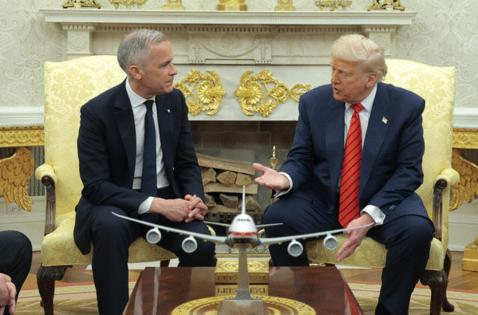Commentary: Making energy abundance a reality -- Upcoming G-7 summit gives US, Canada a unique opportunity
Published in Op Eds
With the upcoming G-7 summit set in Alberta—Canada’s energy heartland—President Donald Trump and Prime Minister Carney are uniquely positioned to champion a bold vision: reasserting and securing North American energy dominance.
Doing so wouldn’t represent just a win for the United States and Canada. It would create a strategic advantage for their European and Asian allies as well.
The G-7 should embrace energy abundance by cooperating and committing to a rapid expansion of energy infrastructure. Members should commit to streamlined permitting, including a one-stop shop for permitting and environmental review, to unleash the capital investment necessary to make energy abundance a reality.
North America’s energy success story is built on deep continental integration and a relentless entrepreneurial drive. Together, these forces have made the region one of the most prosperous and energy-secure in the world.
From the earliest days of oil’s rise as a dominant energy source, the United States has led the way—not only in exploration and discovery but also in building the world’s most advanced and expansive refining infrastructure.
Today, global refining capacity stands at over 103 million barrels per day. Remarkably, nearly one-fifth of that—18 million barrels—is processed in the United States alone.
These refineries are economic engines, directly employing nearly 65,000 Americans in high-paying jobs. With median earnings around $95,000 and many workers earning six-figure salaries, the industry supports a thriving middle class. An additional 1.4 million Americans work in supply chains and corporate operations that keep these refineries running.
To maintain this momentum, the U.S. relies heavily on its own oil production—averaging 13.2 million barrels per day last year, primarily light crude. But here’s the catch: American refineries are optimized for heavy crude, which is more cost-effective and essential for maximizing output and profitability.
Enter Canada and Mexico. Canada supplies 2.8 million barrels of heavy crude daily to U.S. Midwest refineries, while Mexico contributes another 780,000 barrels to Gulf Coast facilities. This steady flow of heavy crude is vital—it keeps energy costs low and allows the U.S. to export its higher-value light crude, advancing President Trump’s vision of energy dominance.
Consider this: the $99 billion in crude oil imported from Alberta alone is transformed by U.S. refineries into $361 billion worth of energy products—much of which is exported. Every day, the U.S. sends 780,000 barrels of refined products back to Canada and over 1 million barrels to Mexico. This seamless energy integration benefits all three nations.
The same synergy powers the natural gas sector. A vast, interconnected pipeline network spans the continent, bolstering U.S. energy security with stable, predictable supplies from Canada and Mexico. This not only supplements domestic production but also fuels booming exports.
Thanks to competitively priced Canadian gas, Americans in the Midwest, Mountain West, and Pacific Northwest enjoy lower energy costs. Excess gas flows to the Gulf Coast and Maryland, where it’s liquefied and shipped to Europe and Asia.
This system enables the U.S. to export 11.5 billion cubic feet of liquefied natural gas daily—generating revenue, creating jobs, and providing allies with a secure, pressure-free alternative to Russian and Chinese energy.
The G-7 summit will spotlight this powerful continental alliance. Nations like Japan, France, Germany, Italy, and the UK are urgently seeking reliable energy sources—not just to meet rising demand, but to reduce dependence on volatile suppliers like Russia and Iran.
North America is ready to answer that call. With its unmatched resources and infrastructure, and reformed permitting regulations, the continent can become the trusted energy partner the world needs.
The United States, with its robust pipeline networks reaching both coasts, is well-positioned to meet Europe’s energy demands—advancing President Trump’s agenda while boosting exports and revenues.
Meanwhile, Canada’s expanding infrastructure to its western ports opens the door to supplying key Asian allies like Japan, South Korea, and Taiwan.
The upcoming G-7 summit is more than a diplomatic gathering—it’s a moment to reaffirm North America’s leadership in the global energy arena. Let’s not waste it.
____
Diana Furchtgott-Roth is the Director of the Center for Energy, Climate and Environment at the Heritage Foundation. Daniel Dufort is the CEO of the MEI, a Canadian think tank with offices in Montreal, Ottawa and Calgary.
_____
©2025 Tribune Content Agency, LLC.

























































Comments